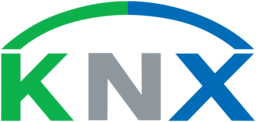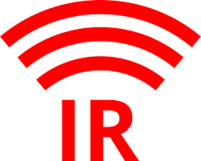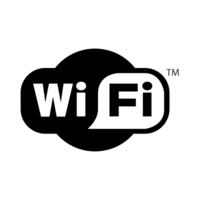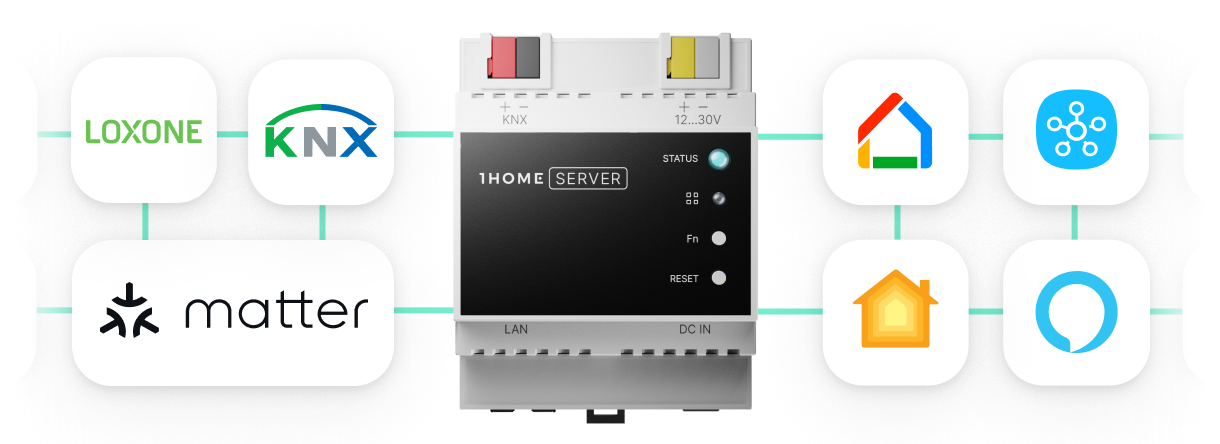
What makes smart home products and appliances smart is the ability to speak the same language and get connected with each other wirelessly or via wired layers. A home or office where many different objects are connected with each other is no longer a dream but has become reality nowadays.
One option to integrate devices of different protocols is with the help of the 1Home Box or Bridge device. This lets you connect and control wireless (e.g. Apple-supported sensors) devices and wired (e.g. KNX lamps) devices together.
See how: https://www.1home.io/how-it-works/apple-knx/
When we mention that the devices need to speak the same language, we mean that they need to be a part of the same protocol.
What are protocols?
Protocols are different methods of communication—how signals are sent from one device to another in order to execute an action, e.g. light control or lowering the blinds. When choosing devices for automating your home it’s important to understand the differences between protocols to choose the one that works best for you.
Each of them has their pros and cons, some are open standards (e.g. KNX, Zigbee) and others are closed to only some licensed manufacturers (e.g. Z-Wave).
In general the smart home protocols aren’t compatible with each other, however you can purchase a hub that supports two of these protocols. If you prefer more freedom to add devices from different brands to your smart home ecosystem, we advise you to do some research before acquiring a new smart device. This way you can minimize the annoyance of finding out you’ve purchased an incompatible device.
Some of the major protocols used in smart homes are: KNX, Thread, Infrared, WiFi, Bluetooth, Zigbee and Z-Wave.
Here’s a few words about each of them to give you an idea of what separates them:

KNX: is one of the most popular protocols for light and building automation. KNX is an open protocol that’s been around for decades already. It operates on more than one physical layer (twisted pair wire, power line, infrared, ethernet and RF. Read more about KNX communication systems HERE).
What makes it stand out is that each device in a KNX system is smart in itself and doesn’t rely on other parts in order to function. A big advantage: if one unit fails, the others can still proceed with their daily business.

Thread: is a new wireless communication protocol that was designed and developed by a group of companies, among them Samsung, Nest, OSRAM and QUALCOMM. It's a low powered (designed for battery-powered devices) mesh network protocol for IoT products.
It works using a secure IP-based standard that makes it easy to alter and add devices. Its specialty is that devices are able to communicate with each other even when some of the devices routing the traffic die, as the network will auto reconfigure.
Thread’s biggest benefit is that its network doesn’t fail due to its ability to self-heal and auto-reconfigure while not needing a central gateway to connect it to IP. It solves many of the challenges of the IoT, such as interoperability, power, security and architecture requirements.

Infrared: is one of the simplest protocols that is often used as a base protocol on top of which smart home companies implement their logic. It usually offers only one-way communication. It’s a popular choice for devices such as AC units and TV remote controls.

WiFi: is also fast and reliable as long as the network infrastructure is set up well and the main router does not fail. Many smart home companies decide to base their proprietary communication systems on top of WiFi as it removes the need of having a central gateway that connects the devices to IP.

Bluetooth: is a wireless mesh protocol used mostly on phones, speakers and headphones due to its short range (10 m). The main feature is its ability to detect existing signals, e.g. WiFi, and negotiate a channel map for Bluetooth devices to minimize interference.

Zigbee: is another wireless protocol, it uses a device to relay a signal to other devices while strengthening it and also expanding the network. Zigbee is built into dimmers, thermostats, door locks and other similar devices and it also defines an application level logic (e.g. Philips Hue lamps connect via Zigbee)
Your new all-in-one KNX / Loxone Server.


Z-Wave: similar to Zigbee, Z-Wave is also a wireless mesh protocol. The main difference is that Z-Wave is slower (cca 6x slower) than Zigbee and since it is a more closed system, has less devices on the market working with it.
Its feature is that it requires a lot less energy to cover the same range as Zigbee. (e.g. SmartThings use Z-Wave).
More about Thread
The internet runs on IP (phones, routers, …) regardless of what connectivity tech is used (Ethernet, WiFi, LTE, …). And what Thread does is address the need for a better way to connect smart building products.
Thread is the networking technology that brings the internet to the Internet of Things by supporting the Internet Protocol version 6 (IPv6)-based mesh network.
Thread also allows to securely connect devices to the cloud, making it a lot easier to control IoT products and systems from smartphones and tablets. Since it’s an IP-based open standard, it allows smart home devices to securely and reliably connect directly to the cloud. Thread networks are secure, self-healing, low latency and reliable. Due to the native IP support, gateways or hubs are not needed.
The above are just some of the advantages Thread has over other standards.
For instance, a single application layer such as the new smart home standard being developed named Matter (ex Project CHIP), that will connect Apple HomeKit, Amazon Alexa, Google Home and others, could run on devices connected via both Thread and WiFi.
This will create a big network of interoperable products and at the same time allow manufacturers to choose the right networking tech for their needs.
KNX and Thread
In this article I would like to discuss the strategic application layer partnership between KNX and Thread that was announced in 2017.
Firstly a few words about Thread Group to clarify what this union is all about and clarify any misunderstandings about what it is and isn’t. Thread Group is a technology alliance and not just another standards defining organisation (SDO). What defines them is that they’re independent, vendor-neutral and open for anyone to join.
As mentioned above, their board of directors come from different smart home fields, from Apple, Siemens, Google Nest, Lutron, Silicon Labs, OSRAM and others, all working together to promote the Thread networking protocol.
The Thread networking protocol that I’ve mentioned briefly above among other protocols is low power, secure and future-proof mesh network technology ideal for IoT products. It supports multiple access points and is self-healing.
What does this self-healing property mean? It means that if one Thread router disconnects from the mesh network, the end devices are able to find and connect to another one and thus stay online. More about Thread routers and end devices will be explained below.
Thread ensures end-to-end communication, encompassing all, device-to-device, device-to-mobile and also device-to-cloud communication. To understand how Thread works, it’s crucial to understand what it consists of.
A Thread network is made up of:
- Border router: usually more than one. They connect the Thread network to the local IP network and the internet.
- Thread devices: that function as Thread routers at any time to expand the mesh.
- Battery-powered end devices: that can sleep at any time to save battery life.
Where does KNX come in?
In 2017, KNX announced that they have chosen Thread as the low-power wireless communication protocol for KNX IoT. The two protocols have partnered to begin with incorporating Thread’s IP-based networking layer with KNX’s well-established and interoperable application layer that will address use cases in the commercial building domain.
Thread is a way for KNX to connect to IoT. This is done with a KNX IoT Point API software via Ethernet or WiFi to a Thread Border router. From there anyone could extend their classic KNX devices with IoT devices either via Thread or WiFi. You can pick one of those connection types or both at the same time.
Via Thread it looks like this:
What is KNX IoT?
The KNX IoT solution is defined in partnership with key KNX manufacturers and standardisation bodies, among those is also Thread.
In order to lower the barrier to access KNX, reduce the knowledge required and ensure that its value is increased, KNX has decided to integrate IoT under the name “KNX IoT”.
“KNX takes a leading position in working with the Internet of things and we offer different kinds of IoT solutions.”
- KNX organization
What KNX IoT will do is make KNX installations part of the internet of things and thus support diverse interactions between KNX and 3rd party IoT equipment. The core of KNX IoT will still be secure connectivity, however this time not wired, but wireless via the IP based devices. This will add support for many new products and features, while the classic KNX products will still be available to be chosen.
Current state of KNX Thread partnership?
At the moment there are already some Thread devices on the market. Here is an up to date list of currently Thread certified products.
However not for KNX yet but for Apple HomeKit, even though the partnership has been announced 4 years ago now.
There is an option to gain access to Thread devices in a KNX home by integrating Apple HomeKit with the 1Home Box or Bridge device. This way you can control your wireless Apple devices on Thread and KNX devices together.
See how: https://www.1home.io/how-it-works/apple-knx/
There are a wide variety of great reasons why Thread will be a great addition to KNX IoT, here are just some of the bigger ones:
Benefits of Thread:
- Built for IoT (low energy footprint, secure and reliably connectivity, no single point of failure, interoperability, scalability, based on proven standards)
- IP-based (ease of development, application layer choices, multiple ecosystems)
- Convergence (seamlessly and securely works with users’ existing networks, creates a network of interoperable products, extends the internet into low power end devices)
- Market-ready (publicly available spec, active certification program, global solution)
- Future-proof (enables interoperability across a broad range of connected devices).
It’s time to start KNX Thread! All the ingredients are ready, both from Thread’s side as well as several applications standards side, among them also KNX. Homes and buildings are about to get interconnected as multi standards will get integrated.
We are looking forward to the rollout of more Thread products, the introduction of Matter and Matter-supported building systems that are just around the corner.
Your new all-in-one KNX / Loxone Server.

